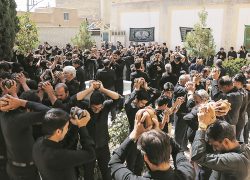Archive Iranian culture

Traditional Skills of Building and Sailing Iranian Lenj Boats in the Persian Gulf:
The World’s Floating Heritage!
Iranian Lenj vessels are traditionally hand-built and are used by inhabitants of the northern coast of the Persian Gulf for sea journeys, trading, fishing and pearl diving.

The Ritual of Jeghjegheh-Zani in Abyaneh:
A Wooden Orchestra
The ritual of jeghjegheh-zani is held on Tasu’a morning, in the villages of Abyaneh and Tareh and some other villages of Natanz County.

The Ritual of Sang-Zani in Shahreza:
Grieving Stones
The Bani Assad Congregation, known as the Sang-Zan-ha, is a well-established religious group in Shahreza, which performs its unique ritual in this city from one day before Tasu’a (Muharram 9) until the 13th day of Muharram.

The Ritual of Hoom Babaei:
Children’s Myths of Ramadan
Nowadays, this belief has become a tradition, and on this night, a number of children, teenagers, and young people, called the Hoom Babaei group, go to the doors of houses after iftar and ask for help for the people in need.

The Traditional Ritual of Jirjirouni in Dastjerd Village:
The Proof of the Pudding Is in the Eating
The 27th of Ramadan is the best time to visit Dastjerd Village in Jarqavieh Olya District, which is located in the southeast of Isfahan, and participate in the Jirjirouni Ceremony.

A Muharram Ritual in Kashan:
Hexagon on the Shoulders
When it comes to the Muharram rituals of Kashan, the sixth day of Muharram is dedicated to carrying the hexagon.

Naqqāli, Iranian Dramatic Story-Telling:
The Oldest Dramatic Performance
Naqqāli is the oldest form of dramatic performance in the Islamic Republic of Iran and has long played an important role in society, from the courts to the villages.

The Ritual of Cooking Samanou in Shahreza:
Winter’s Charity
Cooking samanou in Shahreza is more common in winter, on the nights of the death or birth anniversaries of the Imams, and in the last week of the year for the Nowruz table.

A Rainmaking Ritual in Azaran Village, Kashan County:
Staring at the Sky
Having disappeared in most parts of Iran, the celebration of Abrizan (Tirgan) is still breathing in a valley named Abderaz, which stretches on the slopes of Mount Chal-Azaran, the second highest mountain of Kashan.

Wedding Traditions in Isfahan:
The Brides of Isfahan
Women of the boy’s family choose a girl for him and then go to her family’s house in order to meet the girl and become more familiar with each other.

Kotal Ceremony of Nushabad:
Muharram’s Children
Kotal is one of the most magnificent Ashura rituals. It is filled with secrets, symbols and signs. In some sources, kotal is defined as an embellished horse.

Ritual Dramatic Art of Ta‘zīye:
Poetic Religious Performances
Ta‘zīye (or Ta’azyeh) is a ritual dramatic art that recounts religious events, historical and mythical stories and folk tales.






